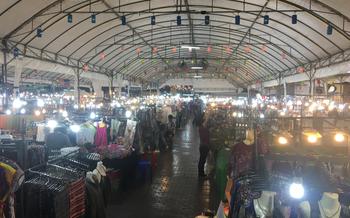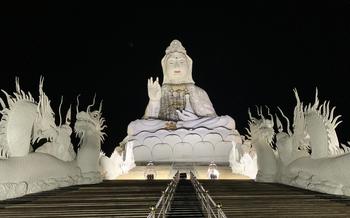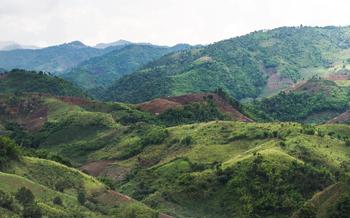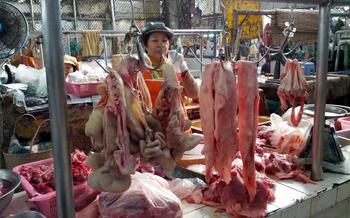
Lahu Village
- Getting to Lahu Village
- Village Tour Highlights
- Lahu Traditional Dress
- Lahu Cuisine
- Lahu Shamanism
- Lahu Festivals
- Homestay Experience
- Lahu Handicrafts
- Lahu Music and Dance
- Lahu Language
- Respecting Local Customs:
- Best Time to Visit
- Photography Tips
- Insider Tip: Unveiling a Breathtaking Panoramic View
Getting to Lahu Village
Transportation Options From Chiang Mai and Mae Hong Son
To reach the Lahu Village, you will need to first travel to either Chiang Mai or Mae Hong Son, the two main cities in the region. From Chiang Mai, you can take a bus or a van to Mae Hong Son, which takes approximately 6-7 hours. Once in Mae Hong Son, you can hire a local guide or arrange a tour to take you to the Lahu Village. The drive from Mae Hong Son to the village takes about an hour and offers stunning views of the surrounding mountains and valleys.
Tips for Hiring a Local Guide or Arranging a Tour
Hiring a local guide or booking a tour is highly recommended for your visit to the Lahu Village. A knowledgeable guide can provide valuable insights into the Lahu culture and traditions, helping you make the most of your experience. When choosing a guide or tour operator, be sure to inquire about their experience working with the Lahu community and their commitment to responsible and ethical tourism practices.
Village Tour Highlights
Strolling through the Lahu Village, visitors are immersed in a world of traditional bamboo houses, each adorned with intricate carvings and vibrant colors. These structures, built on stilts to protect against floods and wild animals, offer a glimpse into the Lahu's deep connection to nature.
Within the village, the rhythm of daily life unfolds, showcasing the community's unique customs and traditions. Farmers tend to their fields, cultivating rice, vegetables, and fruit, while women skillfully weave intricate textiles using traditional techniques passed down through generations. Visitors are welcome to observe these activities, gaining insights into the Lahu's self-sufficient lifestyle and their deep respect for the land.
Beyond these daily tasks, the Lahu also engage in various crafts, such as bamboo weaving and silversmithing. Visitors can witness these artisans at work, creating beautiful and functional items that reflect the Lahu's creativity and resourcefulness.
Lahu Traditional Dress
The Lahu people are renowned for their vibrant and intricate traditional attire, which holds deep cultural significance. Women wear colorful skirts adorned with intricate embroidery, often featuring motifs inspired by nature and their ancestral beliefs. These skirts are paired with blouses or jackets and adorned with handmade silver jewelry, including necklaces, earrings, and elaborate headdresses.
The men's traditional attire consists of loose-fitting pants, often made from handwoven cotton or hemp, and a long-sleeved shirt. They also wear a sash or belt around their waist, which serves both a practical and decorative purpose. Like the women, men also wear silver jewelry, such as rings, bracelets, and necklaces, which are often adorned with intricate designs and symbols.
The Lahu people take great pride in their traditional dress, which is not only a symbol of their cultural identity but also serves a practical purpose. The colorful fabrics and intricate embroidery help to protect the wearer from the sun and insects, while the loose-fitting garments allow for freedom of movement during daily activities.
Visitors to the Lahu Village have the opportunity to purchase handmade Lahu textiles and souvenirs, including traditional clothing, scarves, and other items. These items not only serve as beautiful mementos of your visit but also support the local economy and help to preserve the Lahu's rich cultural heritage.
Lahu Cuisine
A Culinary Journey into Lahu Traditions
Food holds a central place in the Lahu culture, symbolizing community and togetherness. Their cuisine is a unique blend of fresh local ingredients, aromatic herbs, and traditional cooking techniques.
A staple of the Lahu diet is sticky rice, steamed in bamboo tubes over an open fire, resulting in a fragrant and slightly chewy texture. Sticky rice accompanies almost every meal, acting as both a utensil and a base for various dishes.
One of the most popular Lahu dishes is bamboo shoot curry. Tender bamboo shoots are simmered in a spicy coconut milk-based curry, creating a flavorful and aromatic dish. The Lahu also excel in preparing meat dishes, using locally-sourced pork, chicken, and buffalo. These meats are often grilled or stewed with fresh herbs and spices, resulting in succulent and flavorful creations.
The Lahu dining experience is a communal affair, with families and friends gathering around a large table to share a meal. Food is served on large platters, and diners use their hands to eat, demonstrating the community's close bond and trust.
Visitors to the Lahu Village have the opportunity to sample these traditional dishes and immerse themselves in the Lahu's unique culinary traditions. Homestays and local restaurants offer a variety of Lahu specialties, allowing visitors to experience the flavors and aromas of this vibrant culture.
Lahu Shamanism
The Lahu people hold a deep belief in the power of shamanism, which plays a significant role in their community. Shamans, known as "moh-pee," are revered individuals who serve as healers, spiritual guides, and intermediaries between the physical and spiritual realms.
During a traditional Lahu healing ceremony, the shaman enters a trance-like state, allowing their spirit to travel to the spiritual world. Through their connection with the spirit realm, the shaman diagnoses illnesses, dispels evil spirits, and restores harmony to the individual's body and soul.
The healing ceremony is a sacred ritual that involves chanting, prayers, and the use of traditional herbal remedies. The shaman, adorned in colorful attire and elaborate headdresses, performs a series of rituals to appease the spirits and restore balance to the patient.
Witnessing a Lahu healing ceremony is a unique and awe-inspiring experience that provides a glimpse into the spiritual beliefs and practices of this fascinating community. Visitors are encouraged to approach the ceremony with respect and reverence, as it holds deep cultural and religious significance for the Lahu people.
Lahu Festivals
The Lahu people celebrate various festivals throughout the year that showcase their rich cultural heritage and traditions. One of the most significant festivals is the Lahu New Year, which marks the beginning of a new agricultural cycle. During this festival, the Lahu perform traditional dances, sing folk songs, and share feasts with their community members.
Another important festival is the Lahu Fire Festival, which is held to honor their ancestors and pay respect to the spirits of the forest. During this festival, the Lahu light bonfires, chant prayers, and perform rituals to seek blessings for the coming year.
If you plan your visit during one of these festivals, you will have the opportunity to witness the vibrant colors, lively music, and joyous atmosphere of these celebrations. It is a great way to immerse yourself in the Lahu culture and gain a deeper understanding of their traditions.
Tips for attending a Lahu festival:
- Be respectful and ask permission before taking photographs or videos of the festival proceedings.
- Dress modestly and avoid wearing revealing clothing.
- Be mindful of your behavior and actions, as you are a guest in their community.
- Enjoy the festivities and immerse yourself in the vibrant atmosphere of the Lahu festivals.
Homestay Experience
Enhance your Lahu Village experience by opting for a homestay. This unique opportunity allows you to immerse yourself fully in the Lahu way of life, gaining a deeper understanding of their customs and traditions. Homestays typically involve staying overnight in a traditional Lahu bamboo house, sharing meals with the family, and participating in their daily activities.
Benefits of a Homestay Experience:
-
Intimate Einblicke: Homestays provide an intimate glimpse into the daily lives of the Lahu people, allowing you to witness their farming practices, cooking methods, and other aspects of their culture firsthand.
-
Cultural Exchange: Engage in meaningful conversations with your host family, learning about their history, beliefs, and perspectives. Share your own experiences and create a cross-cultural connection.
-
Authenticity: Homestays offer a more authentic experience compared to staying in a hotel or guesthouse, as you'll be living among the Lahu community and participating in their daily rhythm of life.
Tips for a Successful Homestay:
-
Be Open-Minded: Embrace the opportunity to experience a different way of life and be open to trying new things.
-
Respect Local Customs: Familiarize yourself with Lahu customs and traditions, and be respectful of their way of life.
-
Participate Actively: Engage in activities with your host family, such as cooking, farming, or weaving, to gain a deeper understanding of their culture.
-
Ask Questions: Don't hesitate to ask your host family questions about their lives and customs. This shows your genuine interest and helps foster a connection.
-
Give Back: Express your gratitude to your host family by bringing small gifts or contributing to the household expenses.
Lahu Handicrafts
The Lahu people are renowned for their intricate bamboo handicrafts, woven textiles, and silver jewelry. Their skills in crafting these items have been passed down through generations, and each piece is a testament to their artistry and cultural heritage.
Bamboo Handicrafts: The Lahu are masters of bamboo weaving, creating a variety of functional and decorative items. From baskets and mats to musical instruments and even entire houses, their bamboo creations showcase their ingenuity and resourcefulness.
Woven Textiles: The Lahu women are skilled weavers, creating colorful and intricate textiles using traditional backstrap looms. Their fabrics often feature vibrant patterns and motifs that hold cultural significance, representing their identity and traditions.
Silver Jewelry: Lahu silversmiths create exquisite jewelry pieces, using intricate techniques to mold and shape the metal into beautiful necklaces, bracelets, and earrings. These ornaments often incorporate traditional Lahu designs and symbols, making them unique and meaningful.
Unique Souvenirs: Visiting the Lahu Village offers an opportunity to purchase these handmade crafts as souvenirs. Whether it's a finely woven textile, a skillfully crafted bamboo basket, or a piece of intricate silver jewelry, each item carries a piece of the Lahu culture and makes a lasting memento of your visit.
Lahu Music and Dance
Music and dance play an integral role in the cultural fabric of the Lahu community. Their traditional music is characterized by the use of bamboo instruments, such as the khène, a mouth organ, and the pi, a bamboo flute. The Lahu also have a unique style of drumming that adds a rhythmic beat to their music.
Their dances are graceful and expressive, often depicting stories from their history and mythology. The Lahu dance is a popular performance that showcases the community's rich cultural heritage. Performed by both men and women, the dance involves intricate movements, colorful costumes, and synchronized steps.
Attending a traditional Lahu music and dance performance is a captivating experience that allows visitors to witness the vibrant spirit of this community. These performances are often held during festivals and special occasions, providing a glimpse into the Lahu's deep connection to their culture and traditions.
Lahu Language
The Lahu language, belonging to the Tibeto-Burman language family, is a testament to the rich linguistic diversity of Thailand. It is spoken by the Lahu people and is closely related to other languages spoken by ethnic groups in the region. The Lahu language is characterized by its unique tones and grammar, which can be challenging but rewarding to learn.
If you are interested in immersing yourself in the Lahu culture, consider learning a few basic Lahu phrases. This will not only enhance your interactions with the villagers but also demonstrate your respect for their traditions. You can find resources online or hire a local guide who can teach you some essential phrases.
Learning the Lahu language can open up a new world of communication and understanding. It allows you to engage with the villagers on a deeper level, learn about their history and customs, and gain a greater appreciation for their unique way of life.
Respecting Local Customs:
When visiting the Lahu Village, it is crucial to be mindful and respectful of their local customs and traditions. As a guest in their community, it is important to adhere to certain guidelines to ensure a positive and ethical interaction.
-
Dress Modestly: Avoid wearing revealing or skimpy clothing as it may be considered disrespectful in the Lahu culture. Opt for modest and appropriate attire that covers your shoulders and knees.
-
Ask Permission: Before entering a Lahu home or taking photographs, always ask for permission from the villagers. This shows respect for their privacy and helps to maintain a harmonious relationship.
-
Avoid Touching: Physical contact, especially with members of the opposite sex, is generally not encouraged in the Lahu culture. Be mindful of personal space and refrain from touching or hugging the villagers.
-
Be Open-Minded: Embrace the opportunity to learn about the Lahu culture and way of life. Ask questions, listen to their stories, and be open to new experiences and perspectives.
-
Support Local Economy: Contribute to the sustainability of the Lahu community by purchasing their handmade crafts, textiles, and souvenirs. This supports their livelihood and helps preserve their cultural heritage.
-
Promote Ethical Tourism: Encourage responsible and ethical tourism practices by respecting the environment, avoiding littering, and refraining from disruptive behavior. Leave a positive impact on the village and its people.
Best Time to Visit
The best time to visit Lahu Village is during the dry season, which runs from November to April. During this time, the weather is pleasant, with cool nights and warm, sunny days. This makes it ideal for exploring the village and its surroundings on foot. Additionally, the dry season coincides with several Lahu festivals, such as the New Year's Festival in January and the Harvest Festival in March. These festivals offer a unique opportunity to witness the Lahu's rich cultural traditions and participate in their vibrant celebrations.
It's important to avoid visiting during the rainy season, which lasts from May to October. During this time, the village can become muddy and difficult to navigate, and many of the outdoor activities are not possible. Additionally, the heavy rains can make it difficult to appreciate the stunning scenery that surrounds the village.
Photography Tips
When visiting the Lahu Village, it's important to be mindful of the local customs and traditions regarding photography. Always ask for permission before taking photos of the villagers, especially if they are engaged in private activities or religious ceremonies. Be respectful and avoid using flash photography, as it can be intrusive and disruptive.
To capture the essence of the village and its people, focus on candid shots that showcase their daily life activities, such as farming, weaving, or cooking. Pay attention to the details of their traditional dress, intricate bamboo houses, and the surrounding natural beauty.
Remember, the Lahu people are proud of their culture and heritage, and they appreciate visitors who show respect and genuine interest. By following these photography tips, you can not only capture beautiful memories but also contribute to the preservation of their unique way of life.
Insider Tip: Unveiling a Breathtaking Panoramic View
Amidst the enchanting Lahu Village, there lies a hidden gem waiting to be discovered. Venture beyond the main trails and seek out a secluded spot that offers a breathtaking panoramic view of the surrounding mountains. This secret viewpoint is known only to a few and provides a unique opportunity to immerse yourself in the tranquility of nature.
To find this hidden gem, follow the path that leads to the edge of the village and continue upwards, past the last row of houses. As you ascend, the landscape gradually transforms, revealing rolling green hills and distant peaks shrouded in mist. Keep climbing until you reach a clearing where a large rock formation juts out, providing a perfect vantage point.
Settle down on the rock and let the panoramic vista unfold before you. The lush valleys, verdant forests, and majestic mountains create a breathtaking tapestry that will leave you spellbound. Breathe in the fresh mountain air and soak in the tranquility of the surroundings. This secluded spot is the perfect place to pause, reflect, and appreciate the beauty of the Lahu Village and its natural setting.
For an even more magical experience, visit this viewpoint during sunrise or sunset. As the golden hues of the sky bathe the landscape, the mountains and valleys transform into a canvas of vibrant colors. Capture this enchanting moment with your camera, but remember to do so respectfully and without disturbing the serenity of the surroundings.








